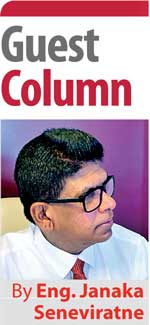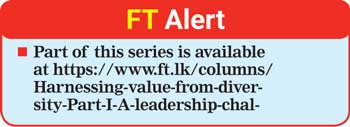Sunday Apr 13, 2025
Sunday Apr 13, 2025
Tuesday, 9 April 2024 00:02 - - {{hitsCtrl.values.hits}}

- Could Sri Lankan corporate and public sector leaders harness the best from the five generations at the workplace?
- The name of the game is teamwork. The objective is the development of a high-performance team, not star individuals
 In the Part I of this article, I talked about the challenge the leaders would have to be prepared to tackle when they are dealing with multi-generations at the workplace. However, the diversity in a multigenerational team is something good to have and it gives an opportunity for the leaders to harness the good.
In the Part I of this article, I talked about the challenge the leaders would have to be prepared to tackle when they are dealing with multi-generations at the workplace. However, the diversity in a multigenerational team is something good to have and it gives an opportunity for the leaders to harness the good.
The following management tips will be useful for the leaders in this endeavour.
Tip 1- Facilitation
Leader should not coach or instruct employees in organisational training sessions. He or she should allow participants from each generation to speak and contribute with their unique strengths. This means that each generation will teach the other spontaneously. Baby boomers would reveal insights about the industry operational activities and the Generation Z would teach all how diversity and inclusion become an integral part of organisational culture. The leader’s job is to make this happen by facilitation. He or she must make sure all have equal opportunity to voice, if one generation tries to dominate. At the end of each training session, all must feel they were equally valued.
Tip 2- Understand Needs and Expectations
One works in an organisation to fulfil one’s needs and expectations. Of course, the employees provide a service to the employer as a means to fulfil these needs. Happiness and contentment of the competent and skilled employees would guarantee the delivery of sustainable service for an employer.
At different ages and at different personal circumstances, employees have various needs and expectations. Hence, the leader should have open and continuous communication with the employees to identify these needs and expectations, if possible, to fulfil these through organisation’s rewarding system. If the organisation is incapable of doing this, it is a situation that a wrong person is in the organisation at the wrong time.
 Tip 3- Displaying Mutual Respect
Tip 3- Displaying Mutual Respect
Being a matured professional, I have a group of majority young professionals to be managed. However, I have a few older persons in my team as well. Naturally my communication style matches with the older people. I found older people respected on my management style. Coincidently, the senior management of Human Resources Division of my organisation consisted of a few matured people as well. They developed HR policies and procedures in line with their upholding-values. Those policies have an undertone of strict demand on compliance and respect. As an example, if you become sick and are unable to attend work, the policy requires giving a phone call to the supervisor. Sending an email, or a text is not an acceptable communication mode. This is an outdated practice for the youngsters who were born with a phone in the hand. While I could not understand why a person cannot pick up the phone and call me, my young team member could not understand why a text would not serve the same purpose. It is a battle of respect of each other’s values, not about an issue with communication modes. I might have a doubt about the genuineness of the person who applies the sick leave and I might have mis-interpreted a text as a mode of avoidance to face me by calling and letting me about his/her sickness. This means that I have put all young employees into a one stereotype basket and name it as “dodgers”. This is wrong and we must understand the unique personality traits and values within each generation. More importantly, we must recognise there are some individuals within a specific generation have differences in personality traits and values due to unique environment they have been brought up. We must be ready to respect those traits and values rather than challenging them.
The first lesson we must learn is the maintenance of mutual respect by debunking stereotypes and generalisations.
Tip 4- Debunking Stereotype Generalisation
As a leader, always there is a first impression of the person who is hired. This first impression is heavily tainted by the prior knowledge of the generation to which the person belongs to or by the prejudice. As an example, members of Generation Z are progressive but disloyal. The leaders must ask the first question themselves, “Could this person be different to the rest of the clan? or could this person be progressive and loyal? Or could this person be non-progressive and loyal? Or at the worst case, could this person be non-progressive and disloyal?”
Hence, rather than blindly accepting generalised view on the Z Generation, the leader must find out his/her degree of deviation from the stereotype mould by doing a desktop investigation, an interview and a thorough observation.
Tip 5- Selection of Communication Methods
There are alternative methods of doing the same work. The method is selected based on the circumstance, surrounding conditions, available resources, urgency, and the expected qualitative and quantitative measures of the outcome etc. This means there is no right and wrong work style. What matters is the desired outcome. In the same vein, there are no right or wrong communication methods. It is just the suitability of the communication style with the matter of communication.
In a meeting, a leader may advise all to send the feedback in wring by a certain deadline about a certain recommendation. May be one member of the team would like to have a verbal one to one discussion with the leader as a mode of feedback. If both became logger-headed with own method of communication, the desired outcome “that is the refinement of recommendation by accommodating feedback” would suffer. Hence, the leader must be ready to suggest all to use own style of communication and to make sure all are recorded in writing by someone using the technology. The leader must slowly challenge all to move out of their own comfort zones to meet everyone at a common ground. When everyone is comfortable with the common ground, a blanket instruction can be issued, and it could work. Always, a mixture of communication styles must be used to value the people’s own preferred styles.
Tip 6- Beware of difference of values and boundaries of topics
Many years ago, the Sri Lankan Cricket team had a player with an unusual hair style. The baby boomers of Sri Lankan professional cricket world expressed their displeasure citing this would tarnish image of Sri Lankan cricket at the international arena. This player defied the odds and performed exceptionally well his craft and the global cricketing fraternity loved him. The rest was history. Nowadays, wearing of a tattoo on the body by international cricketers is no longer frowned upon. Still a Sri Lankan corporate leader may not hire a person wearing a tattoo on his or her neck or even having a ring on an ear, citing that it would be an unprofessional display of company values. Rest of the world has moved on this.
The leader who got a team consisted of five generations has an arduous task of setting team values and ground rules because individuals have varied values. Especially Gen Y and Z are vocal on social issues and social justice. As an example, they have a broader view on lesbian, gay, bisexual, transgender, intersex, queer, asexual (LGBTIQA) people and expect all to accept the reality and allow equal treatment of those people. Even they demand the changing of the public record systems allowing LGBTIQA people to enter their genuine personal information without just recording them as Female or Male. Young people are concerned about environment, sustainability, mental wellbeing and psychological safety. A leader cannot just disregard these concerns and must be open for active discussions. Social justice is another area, the leaders struggle to tackle. Young Sri Lankan people may openly express conflicting views on the treatment of minorities in Sri Lanka. Most probably, majority of young Sinhalese people would say that the minority races in Sri Lanka were treated less fairly. Obviously, there were complex reasons behind this situation and there were various individuals and parties from all races including those from the minorities actively contributed to create this situation. The public were goaded to be a part of this undesirable situation. In my view, this has happened by design and not intentionally by Sinhalese. However, would any of such explanations and reasons be good enough to quell the validity of the statement made by the young Sinhalese people? I am afraid to say “No”. The leader’s starting point of the discussion with the younger generation is to accept the facts or outcomes and move on with solutions to ensure it will not happen in the future. History cannot be changed, but we can learn from it.
Younger generations have more concerns about the present and the future not about the past. They expect equal treatment of all without any bias to the age, race, ethnicity, gender, sex, sexual orientation, religion, physical ability, physical appearance, social class, personality, schools attended and social upbringing. In the corporate sector, obviously the aforementioned parameters play a part in recruitment. The very recent example is the news item how extreme scrutiny of physical appearance played a major criterion on selecting Air Hostesses. It is said that even a tiny pimple on the face led to rejection! Hence, the leaders must be careful of certain boundaries they should not cross when dealing with the younger generations.
International corporate and public sectors have made significant headway in this regard and the current social trend is the acceptance of the young generation to be different and out-of-box thinkers. The corporate and public sector leaders respect values of the others and encourage people to be different and to bring variety to the table.
It should be reminded that the customers also consist of all five generations. Hence, the organisation should obviously have staff representing all five generations. By seeing this representation at the customer service desk, the customers would feel more comfortable to do business. They will have the confidence that “one of them” sitting at the opposite side of the counter, will understand better their needs. Hence, the customers would feel valued.
Tip 7- Discarding favouritism
All leaders have favourite employees. It is a fact. It is a risk aversion approach taken by leaders. However, what they haven’t realised is that such an approach generates new risks. Disharmony, demotivation and poor performance among the rest of the employees are a few risks. The name of the game is teamwork. The objective is the development of a high-performance team, not star individuals. An individual may be able to run his or her lap with the world best timing, but the team would lose the race by an embarrassing margin, if others do not run fast enough. Leaders should allow all to voice their opinions and suggestions irrespective of their age, level of experience and competence. Decision making must be inclusive and based on an open dialogue. If a star performer is identified, hook up the star performer with less performing staff member or members. Thereafter, the star performer must be challenged to make others high performers through collaboration, guidance and coaching. Rewards must be equally distributed with the whole team on success. If one member of the team is performing below the benchmark, unless others support him or her to increase performance above the set benchmark, the team must not be rewarded.
Sometimes allowing all to express opinion works against the team spirit when one starts criticising another member based on differences of own values. This is where the leader should intervene and draw a line that one should not cross. Those ground rules should be applied across the board without any favouritism. Division of team or divisions among business units as “Us vs. Them” should be avoided and discouraged at all cost.
Tip 8- Periodic Check-Ins
The leaders should have one to one check-in with each member of their teams periodically. I personally have 15 minutes fortnight meetings with my leader. A member of each generation expects different things from the leader. Baby boomers look for leaders with strategic vision. Gen X wants practical leaders who are prepared to solve complex problems educating them. Millennials see relationship builders as good leaders, to achieve common goals. These are generalisations and a leader can devise a plan to fulfil these expectations. However, one to one check-ins could identify whether an individual member from the specific generation defies the standard norm and plan accordingly.
Future benefits of proper treatment of diversity
(The writer is a Professional Engineer working in the Australian NSW Local Government Sector. He intends to share his views on various social development areas, in addition to his chosen professional discipline to inspire youth to think differently. He could be reached via email [email protected].)
Discover Kapruka, the leading online shopping platform in Sri Lanka, where you can conveniently send Gifts and Flowers to your loved ones for any event including Valentine ’s Day. Explore a wide range of popular Shopping Categories on Kapruka, including Toys, Groceries, Electronics, Birthday Cakes, Fruits, Chocolates, Flower Bouquets, Clothing, Watches, Lingerie, Gift Sets and Jewellery. Also if you’re interested in selling with Kapruka, Partner Central by Kapruka is the best solution to start with. Moreover, through Kapruka Global Shop, you can also enjoy the convenience of purchasing products from renowned platforms like Amazon and eBay and have them delivered to Sri Lanka.
Discover Kapruka, the leading online shopping platform in Sri Lanka, where you can conveniently send Gifts and Flowers to your loved ones for any event including Valentine ’s Day. Explore a wide range of popular Shopping Categories on Kapruka, including Toys, Groceries, Electronics, Birthday Cakes, Fruits, Chocolates, Flower Bouquets, Clothing, Watches, Lingerie, Gift Sets and Jewellery. Also if you’re interested in selling with Kapruka, Partner Central by Kapruka is the best solution to start with. Moreover, through Kapruka Global Shop, you can also enjoy the convenience of purchasing products from renowned platforms like Amazon and eBay and have them delivered to Sri Lanka.